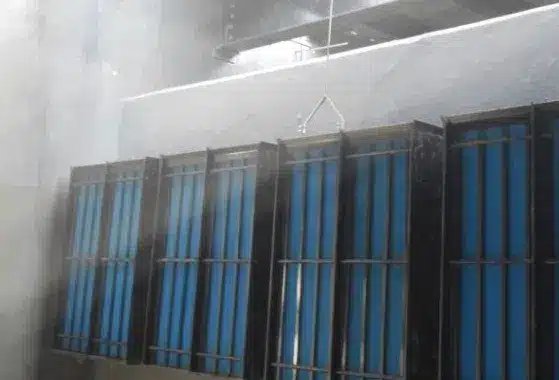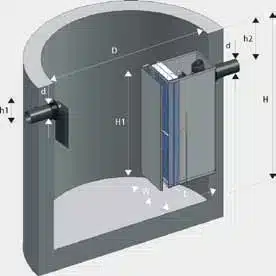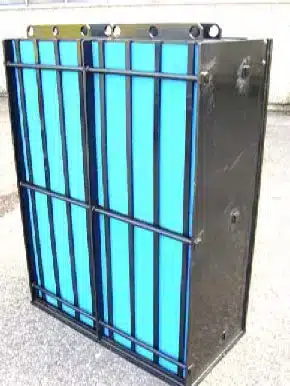Can Alaska’s industries meet the growing need for cleaner water? As the state faces environmental challenges, Oil Water Separator Tanks Alaska are key. They help businesses handle oily wastewater, from small shops to big offshore platforms.
In Alaska, oil water separator tanks are crucial for keeping waters clean. They remove oil and grease from water, helping companies follow environmental laws. With a focus on oily water treatment, Alaska’s industries are using new separation tech to stay compliant and protect the environment.
Many sectors in Alaska need efficient oil water separator tanks. They are vital for managing oily wastewater in everything from car shops to big oil refineries. As rules get stricter and public concern grows, companies are investing in top-notch systems. This ensures they can handle regular discharges and spills.
Key Takeaways
- Freytech Inc. Oil water separator tanks are crucial for Alaska’s environmental protection
- These systems help industries comply with strict wastewater regulations
- Oily water treatment is essential across various Alaskan industries
- Advanced separation technologies improve efficiency and compliance
- Proper wastewater management protects Alaska’s water resources
Understanding Oil Water Separator Tanks in Alaska
Oil water separator tanks are key in Alaska’s industries. They protect water resources and follow strict environmental laws. In Alaska’s tough climate, these systems are essential for many sectors, like offshore oil and vehicle maintenance.
The Importance of Oil Water Separation in Alaska’s Industries
Alaska’s industries need oil water separation to stay clean. Offshore oil platforms in Alaska use these systems to clean water with oil. This process makes sure the water released is safe for the ocean.
Environmental Regulations and Compliance in Alaska
Following environmental laws in Alaska is crucial for businesses. The National Pollutant Discharge Elimination System has tough rules for water release. Companies must use and keep up oil water separators to follow these laws and avoid big fines.
Types of Oil Water Separators Used in Alaska
Alaska’s industries use different oil water separators. Gravity-induced separators are good for non-mixed hydrocarbons, while enhanced coalescing systems separate better. These systems can handle various flow rates and get rid of a lot of oil. Crude oil storage tanks in Alaska often use the latest separator technology to manage big amounts.
Oil Water Separator Tanks Alaska: Features and Benefits
Oil water separator tanks in Alaska are key to protecting the environment and following industry rules. They are vital for preventing oil spills in Alaska’s refineries and industrial sites.
These tanks have easy-access covers for quick checks and upkeep. This makes oil removal and maintenance efficient, even in Alaska’s tough climate.
Many oil water separators in Alaska are UL 2215 Listed and STI Engineered and Labeled. This means they meet high quality and safety standards. They also have strong corrosion protection to handle Alaska’s harsh weather.
Some models have a double-wall design for extra safety. This setup helps prevent leaks and spills. The separators use materials that meet UL standards, making them better at separating oil from water.
These tanks can manage flow rates from 45 to 10,000 gallons per minute. They come in sizes from 300 to 50,000 gallons, fitting the needs of Alaska’s industries. This makes them good for both small businesses and big petroleum refinery setups in Alaska.
Applications of Oil Water Separators in Alaska’s Industries
Oil water separators are key in Alaska’s industrial world. They help manage oily wastewater and protect the environment. Let’s see how various sectors in Alaska use these systems.
Vehicle Maintenance Shops and Small Businesses
Small auto repair shops and businesses in Alaska use compact oil water separators. These units clean oil and water from wash water and runoff. They help businesses follow local rules and reduce their environmental harm.
Offshore Oil Platforms and Refineries
Alaska’s oil industry needs strong oil water separators for big oily wastewater flows. These systems are vital for treating Hydraulic Fracturing Wastewater Alaska. They make sure water released into the environment is safe.
Oil platforms and refineries use advanced separators for Arctic challenges.
Storm Water Management Systems
Municipalities and industrial sites in Alaska add oil water separators to their storm water systems. These separators clean runoff to meet US EPA Clean Water Act standards. They’re crucial for Arctic Exploration Wastewater Treatment Alaska, where weather can affect water quality.
By using oil water separators, industries follow NPDES rules and protect Alaska’s clean environment.
Freytech Inc.’s Advanced Oil Water Separator Solutions
Freytech Inc. offers top-notch oil water separator solutions for Alaska’s tough industrial needs. These systems work well in Alaska’s harsh climate, making sure they run smoothly in extreme weather.
Enhanced Coalescing Technology for Superior Separation
The company’s advanced coalescing tech leads the way in Alaska’s industrial wastewater systems. It’s great at removing free oil from water. This makes it perfect for many industries in the state.
Guaranteed Performance: 5 PPM Separation Efficiency
Freytech’s separators ensure a clean discharge at 5 PPM, beating the North American limit of 10 PPM. For really tough jobs, they can get down to 0.1 PPM for emulsified oil. This meets Alaska’s strict environmental rules.
Customized Solutions for Arctic Conditions
Freytech’s separators are made for Alaska’s varied industrial needs. They handle motor oil, diesel, gasoline, and jet fuel. These strong systems keep treating oily water well in Alaska’s tough arctic, working great all year.
These separators are crucial in storm water systems. They process runoff to meet the US EPA’s Clean Water Act standards. With effective oily water treatment, facilities protect the environment and dodge big fines.










